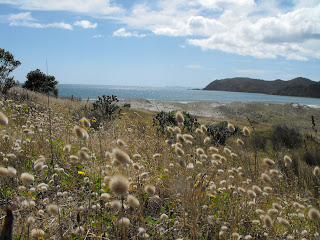Above the high tide mark conditions are only a little less harsh. The first plant you encounter, at the foot of the dunes, is the sea stock. It throngs with bees when it is in flower. Later it's seeds become the food for the introduced greenfinch.
Pingao
Then the native sand binders, Spinifex and Pingao appear holding and building the protective fore dunes. The seed head of Spinifex cartwheeling along the beach in summer is a familiar sight.Spinifex
The dunes favours those plants that have a particular edge. Some are very good at conserving water. Sea Convolvulus
Some, like the sea convulvulus manage to get through their life cycle and produce seed before the harsh summer arrives. Bush lupin
The bush lupin has two advantages at least. It has deep roots so water is less of a problem. In a low nitrogen environment it also gets extra nitrogen from the air. The catchfly, with its sticky leaves and stems also supplements its mineral requirements from the insects which become glued to it.
Getting a free ride is the parasitic broomrape. It has no chlorophyll but gets it's food from the roots of other plants.
Further back from the sea the plant cover becomes more complete and the sand binders more infrequent. Eventually larger plants, more bush like,start to appear and the sand binders are nowhere to be found.
.JPG)






.JPG)



.JPG)



.JPG)


.JPG)
